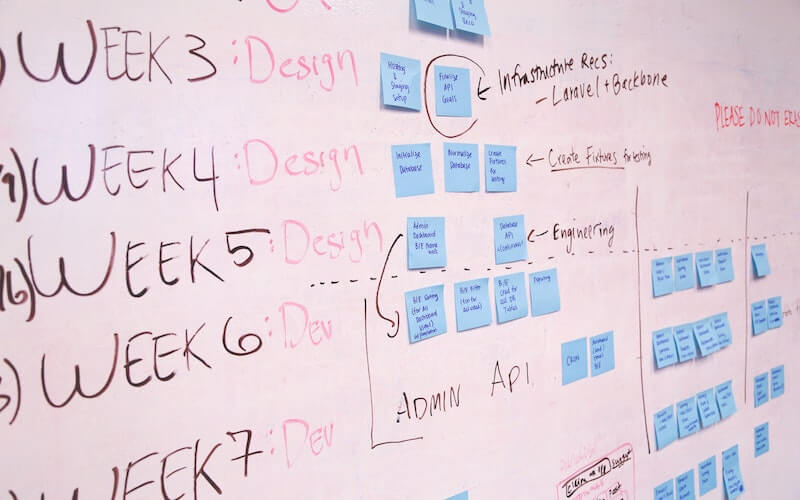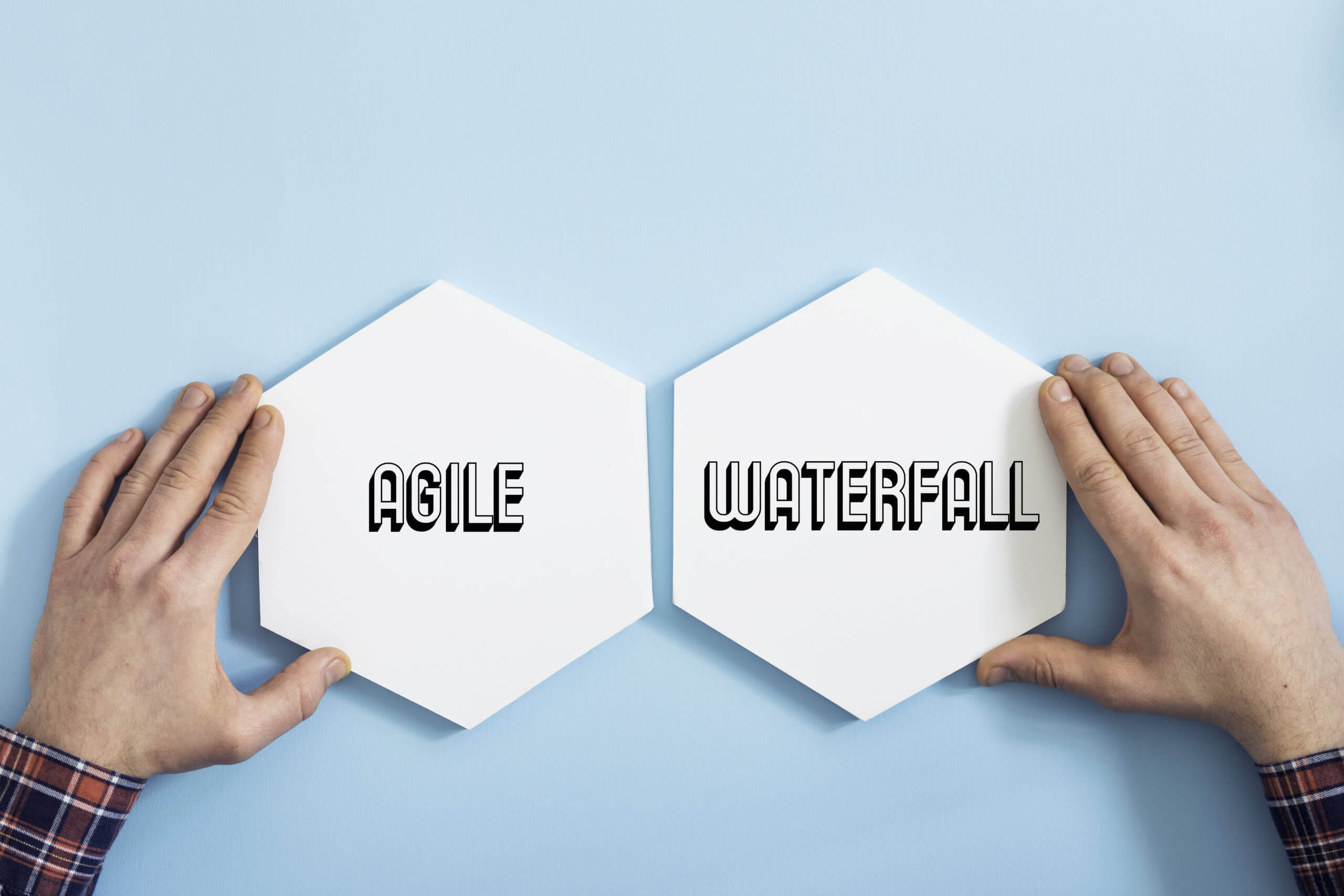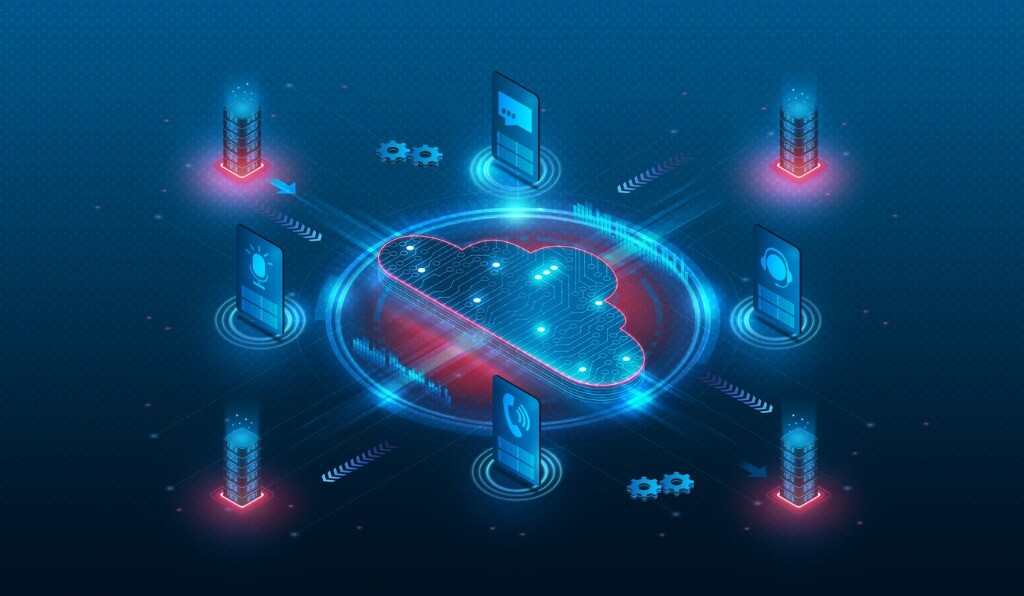Agile vs Waterfall: What is the Difference? Which is Best for You?
Before undertaking any development project, the most important decision to make is how to approach the project as a team. Making this decision can get heated due to the two major development methodologies at play. In simple terms, a development methodology determines how the actual tasks of a project are organized and acted on.
The two main development methodologies are agile and waterfall. They are commonly applied to software development, and thus, project management as well. The main difference between agile and waterfall is that waterfall projects are completed sequentially whereas agile projects are completed iteratively in a cycle.
For those looking for a comprehensive, video guide to Agile versus Waterfall, we have you covered. Below you will find our own video content, explaining the advantages and disadvantages of each methodology.
Both the agile and waterfall methodologies carry their own set of advantages and disadvantages. Overall, both can be beneficial to a software development team. Which one to choose is highly dependent on the project type and circumstances.
Based on a 2019 poll on TrustRadius.com, fewer than one in five professionals said their organization uses the waterfall methodology. 81% said their organization uses the agile methodology instead. According to research done by HP, 54% of agile users say their largest motivator for using agile over Waterfall is that it enhances collaboration and teamwork.
Read on to learn about the differences between agile vs waterfall. We’ll go over the pros and cons of each approach, and explore why more organizations are using the agile methodology today.
Waterfall Methodology
The waterfall approach to software development is highly sequential and can be broken down into seven distinct phases. There is a set line of phases, each following the other, that needs to be completed one by one. Phase two cannot be started until step one has been completed.
The phases of the waterfall methodology are:
- Conception: The idea stage, when developers decide what they want to design and why.
- Initiation & Analysis: This stage involves gathering and documenting what the software development project will require – including system and software requirements for the product or project.
- Design: In this stage, developers determine how they want their piece of software to work and determine which pieces are necessary to code.
- Construction & Coding: This stage involves coding each unit of the software and testing it along the way, as well as integrating units according to the software architecture from the design phase.
- Testing: This involves testing the software system-wide; it may include user testing, bug testing, and going back through to fix any specific issues.
- Implementation: In many cases, this means delivering the ‘finished’ product to the customer or rolling out the system-wide software.
Benefits of the Waterfall Methodology
Because of the rising popularity of Agile methods, Waterfall can be mislabeled as “bad” or “outdated”. There can be some temptation by product teams to follow the trend and go Agile, and that may not be the best choice. Waterfall excels at many aspects, including:
- Clear framework: There is a clear understanding of the project timeline and deliverables before the project begins. The full scope of the project is agreed upon by the development team and their customers in advance.
- Documentation: Each phase of the process is documented in detail to eliminate any misunderstandings or shortcuts.
- Shared load: It does not always take all of a development team’s time and attention. Depending on the phase, individual team members can focus on other aspects of their work.
- Hands-off approach: This approach allows for a more hands-off approach from the customer. Once the initial design and project plan is in place, there is little requirement for ongoing customer presence until the review phase.
Potential Drawbacks
No single approach to software development will work every time, for every team. There are a few drawbacks to the waterfall approach:
- Less customer involvement: A hands-off approach is not suitable for every type of product. Some customers will want more involvement as the project proceeds. If there isn’t a framework for that involvement, the waterfall approach could lead to frustration on both ends.
- Changes can be difficult: The whole point of the waterfall methodology is that it follows clear steps and a set timeframe. Once these elements are in place, it can be difficult to make changes once the development team encounters a roadblock. Adaptability is a crucial part of software development to consider, particularly since it can be hard for customers to have a full grasp of the project before it begins.
- Last-minute testing: Again, one of the drawbacks of waterfall vs. agile is that it is not time-bound. While this can often make for an effective project, more often than not development projects start to run behind schedule. For the coding phase, the problem is often stated as “The first 90 percent of the code accounts for the first 90 percent of the development time. The remaining 10 percent of the code accounts for the other 90 percent of the development time.” The final testing phase consequently gets rushed, which could lead to very buggy code.
Is Waterfall Right for Me?
So, where do these benefits shine?
In the tech world, speed can be everything. This can sometimes come at the cost of stability, organization, and clear frameworks. The waterfall method is well suited to teams that have established, organized methods of development. Waterfall project management ideology is great for consistent, reliable results on software or other systems that are not as rapidly changing. Agile is a massive boon to innovation and burst thinking. Sprint planning and extreme flexibility can be useful, but sometimes that is simply not what a product needs.
In the most simple to understand way, if you do not need agility, Agile is not going to be the best for you. The best project managers know their teams, testers, and resources.
As remote work becomes more normal, there may be circumstances where Waterfall can add a level of structure to development when a manager requires it. This can be especially true if you have teams working on multiple aspects of the system at once. If one person needs to complete their work before another is to start, that fits excellently into Waterfall, which is designed around that. In a chaotic environment, the next phase can get bogged down with too much flexibility.
While many think of Agile as the flexible alternative (and they are largely right), there are areas in 2021 where Waterfall can actually be the more adaptable philosophy. Time-box sprints might not work when people are working with their kids in the room. Perhaps they have to step away to deal with a dog chewing on the table. These can ruin the flow of “sprints”. Crucially, this is not the case for everyone, it is just a possibility. Successful project managers will listen to the situation and learn from their staff, and make decisions accordingly.
For our more visual learners, you can find a recap of waterfall methodology here:
Agile Development
The major difference between agile vs. waterfall might be summarized by saying that the waterfall approach values planning ahead, while the agile approach values adaptability and involvement.
There are several different flavors of agile development that all share some basic similarities. These include:
- Extreme Programming (XP)
- Scrum
- Kanban
- Lean Software Development
- Agile Unified Process
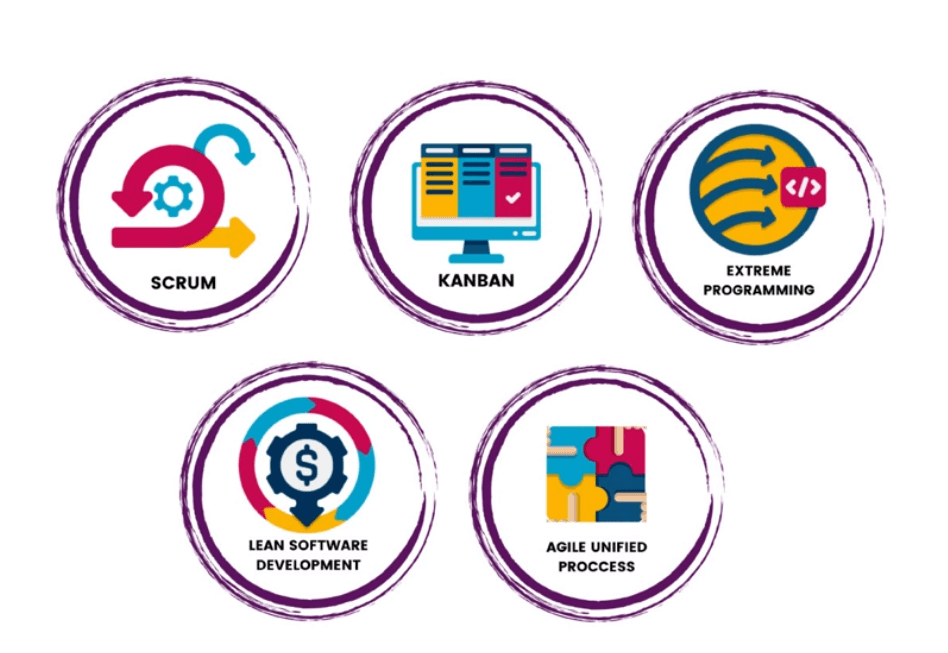
The agile methodology has two core elements: teamwork and time. Instead of creating a timeline for one large software development project, agile breaks the project into individual deliverable pieces. These ‘time-boxed’ phases are called ‘sprints’ and last just a few weeks. Once each sprint is completed, the feedback from the previous phase is used to plan the next one.
Core Principles of Agile Development
With this team and time-sensitive approach, there are several core principles that any agile development project will follow.
- Adaptability: Agile development highlights the importance of being able to change design, architecture, requirements, and deliverables along the way.
- Customer involvement: Because of the constant changes in design and deliverable units, agile software development requires close collaboration between the customer and the development team.
- Lean development: Agile development values making the end product as simple as possible. If the same end result can be achieved with two steps instead of five, agile development will design the software accordingly.
- Teamwork: As we mention above, agile values teamwork almost above all else. Teams must continually assess how they can become more effective and adjust the agile project as they go. Extreme Programming (living up to its name) insists that developers work in pairs on the principle that two heads are better than one.
- Time: Agile development takes a very different approach to time during projects, breaking projects into very small units of time. These are the “time-boxed sprints” described above.
- Sustainability: Instead of pushing for faster deadlines in exchange for an unfinished project, agile development places value on setting a sustainable pace for software development.
- Testing: Unlike waterfall approaches where there is a distinct testing phase, agile approaches insist on testing through every phase of the project.
Agile Development Benefits
The benefits of agile development have everything to do with customer satisfaction and the end result of the development project. The agile technique can be an adjustment, but that work may prove worth it for the right development team.
- Stakeholder involvement: Taking an agile approach to development allows— and actually encourages—continuous engagement between the development team and the customer.
- Flexible deliverables: Agile lets stakeholders set deliverables by order of importance. In other words, if a customer wants to release the basic software before the full suite, this is exactly what agile allows.
- Adaptability: We mentioned adaptability above as a crucial element of agile development, and it is also one of its major benefits. As customers get a better idea of what they need out of the software, the development can adapt planned sprints accordingly.
- A higher quality and user-friendly product: Since customers can provide feedback after each sprint, products developed using the agile methodology often end up being very user-friendly.
Potential Drawbacks
Like any single approach to development, agile may have drawbacks for certain settings or teams. With planning and a dedicated team, these added challenges can be overcome.
- Intense commitment: Unlike waterfall, agile development only works well when the entire development team is committed to the project for the duration. This may be a challenge for some development companies that have a lot going on at once, and may even prove challenging for individual developers.
- Potential for a higher cost and longer deadline: While time-boxed sprints allow for planning, it is always possible that some deliverables will not be completed on time. It’s a simple truth of development projects. Creating the necessary additional sprints may mean a higher project cost for the customer.
- Communication: Since agile requires a high level of collaboration, development projects using this methodology will also require a high level of communication.
Is Agile Right for Me?
Agile development is one based around creativity, teamwork, and intense sessions of focus. At its best, it can create an agile team with many iterations, building on the feedback of the customer. At its worst, it can be a disorganized mess full of backlog and warped phases of development.
The teams that will get the most out of Agile are those who feel constrained by Waterfall and want to unleash their team’s creativity. They will need extremely talented managers, who are able to balance an iterative approach in a more chaotic development cycle. Agile can remove bottlenecks and unleash potential of product teams. It can also end in burnout and a sea of jumbled WIP (work in progress) software.
How do you know if it is best for you? In truth, you probably already do. If you have a team who works in spurts of creative energy, while using organizational software like Kanban boards to prevent confusion, you have the means. If your projects require creativity, rapid changes, and a customer-involved final product, you have the motive. Finally, if you have a management team that can harness this creative power and promote employee wellness and work-life balance, you have the opportunity.
Agile vs. Waterfall in the Best Project Management Software
How do the top project management software solutions on the market compare within the lens of agile vs. waterfall? We took a look at the most reviewed Project Management tools on TrustRadius with reviews that call out agile or waterfall to see how often each development methodology was part of the conversation. Each of these products featured below is customer-verified.
Among the project management tools below, agile is mentioned more often than waterfall across every product. Of the nearly 400 reviews that contain a mention of agile or waterfall, 83% call out agile. That’s in line with the fact that more people use agile development than waterfall development. It’s more common to find project management software designed for agile vs.waterfall.
Jira Software has the most mentions of agile project management, with 58 reviews calling out agile. For waterfall project management, Adobe Workfront leads the conversation with 20 reviews.
Adobe Workfront
Agile is called out 2.2x more often than waterfall.
Insightly
Agile is called out 7x more often than waterfall, which is hardly mentioned.
Trello
Agile is called out 9x more often than waterfall.
Wrike
Agile is called out 9x more often than waterfall, which is hardly mentioned.
Asana
Agile is called out 1.4x more often than waterfall.
Jira Software
Agile is called out 9.6x more often than waterfall.
Real B2B Examples of Agile vs Waterfall
To see how agile and waterfall development styles work in real-life contexts, here are a few examples of how B2B companies incorporate these methodologies:
- Avoiding AgileFall: In his article “When Waterfall Principles Sneak Back Into Agile Workflows”, Steve Blank dives into some of the pitfalls of not having a clear methodology set in the first place. It’s very easy to fall into the “AgileFall” trap of combining agile workflows with waterfall techniques, and that can cause delays and inefficiencies. Steve goes on to speak about how he helped get a client back on track by emphasizing more regular, ongoing communication and feedback in addition to making sure their product developers felt supported throughout the project.
- Agile + Feedback: Given that they are the masters of getting feedback, it is no surprise that SurveyMonkey takes an agile approach to their product development. Agile methodologies stress the importance of regular, on-going feedback. This feedback can be facilitated by phone calls, collaboration tools, web conferences, and of course—surveys. Qualitative feedback helps provide you with the authenticity you need to succeed in the market.
- Agile Reduces Costs: According to Research by CollabNet VersionOne, 71% of organizations choose agile over waterfall, citing cost reduction as the primary reason they adopted an agile approach. However, the waterfall methodology typically requires customer sign-off before the development process begins whereas agile does not. The idea of committing to a specific deliverable is very enticing for more traditional project managers.
- User Feedback is Crucial: With agile, you do run the risk of creating something that doesn’t quite live up to your customers’ expectations. The methodology itself is designed to mitigate some of this risk by receiving “user feedback early on in the development process to avoid unneeded features and allow for the process to be restricted before too much money or time has been invested”, says Nacho de Marco, CEO of BairesDev, an outsourcing development company.
- When Waterfall Really Works: While agile organizations cite cost-savings as a key factor for choosing their methodology, some experts advise small companies, especially startups, that waterfall may be a better choice financially. According to technologist, Eric Boersma, waterfall, in particular, may be suited for companies that already know exactly what their product is and requires, and who cannot spend time experimenting. If your organization puts a higher emphasis on planning ahead and is generally risk-averse, waterfall’s scope-first approach may be best.
How Do You Make the Choice Between Agile and Waterfall?
Which development methodology you go with—agile vs. waterfall—depends very much on several key factors. Waterfall may be best when there is no or limited access to a customer to provide constant feedback. It will best suit projects with a dispersed team, fixed scope, and budget.
Agile is more suitable for larger, more complex projects, where there is easy access to customer feedback. Because of the inherent flexibility of the agile approach, it is preferred for projects with constantly changing requirements.
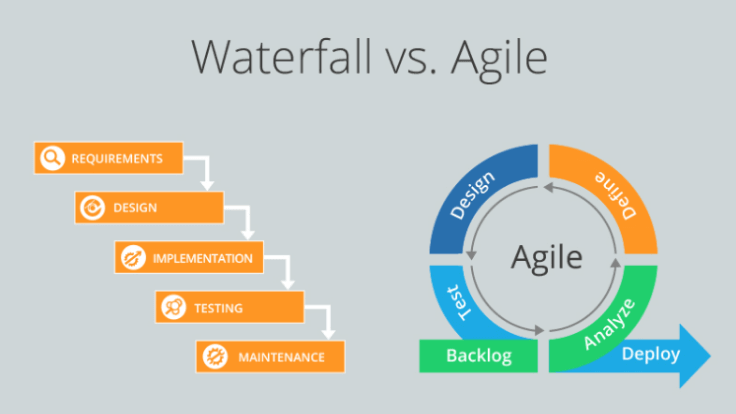
In recent years, agile development became the predominant product development methodology, being used by a large majority of development organizations. Our poll on TrustRadius.com reflects this trend. Only 19% of respondents indicated that their company uses waterfall rather than agile.
Based on their experience, respondents said the worst things about the waterfall methodology are wasted time, trouble managing requirements, adapting to changing needs, that it can be expensive and hard to manage, and ultimately that it can be less satisfying for the developers working on the project as well as the customers receiving the finished product. Because far more organizations are now using the agile methodology, it can also feel out of sync with the industry at large. Developers may feel frustrated that they’re not getting valuable experience working in an agile organization.
Even development teams still using the waterfall methodology tend to use a hybrid approach using both agile and waterfall. Despite the dramatic success of the agile approach, Waterfall is still a valid approach in certain circumstances.
No matter what development methodology you choose, there is a wide selection of project management tools available to you.
Tips for Software Buyers
After deciding which approach to software development or project management you want to take, it can still be difficult to assess just how well a given solution will meet your needs. Here are three things you can do to help evaluate different products for their usability:
Use the full free trial of the software
Set up realistic projects that you and your team would actually be working on. This helps you get a good feel for how difficult the tool is to use and how easy it will be to teach the rest of your team. Plus, you’ll walk away with an indication of if it has all the specific features and integrations you’re looking for.
Ask questions
Ask the vendor questions about all the features you’re looking for and the time it takes to fully learn the software. If your projects will require specific integrations, ask the vendor about these to see how deep the integration goes.
Read reviews
Learn about experiences from fellow project management software users to get a better understanding of the pros and cons of each product you’re considering, the obstacles and challenges others in similar positions and companies have faced, and how they customized the tool to fit their circumstances.
No matter which development method you choose, the right software will help you manage projects with greater efficiency. Authentic, verified reviews are the best place to start looking for that perfect fit. Start reading reviews and building your shortlist here.



